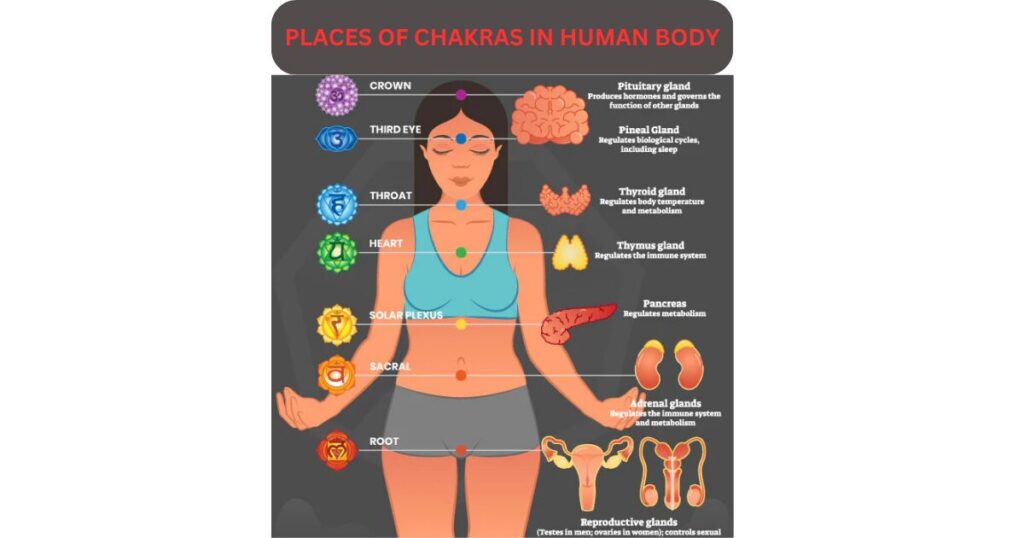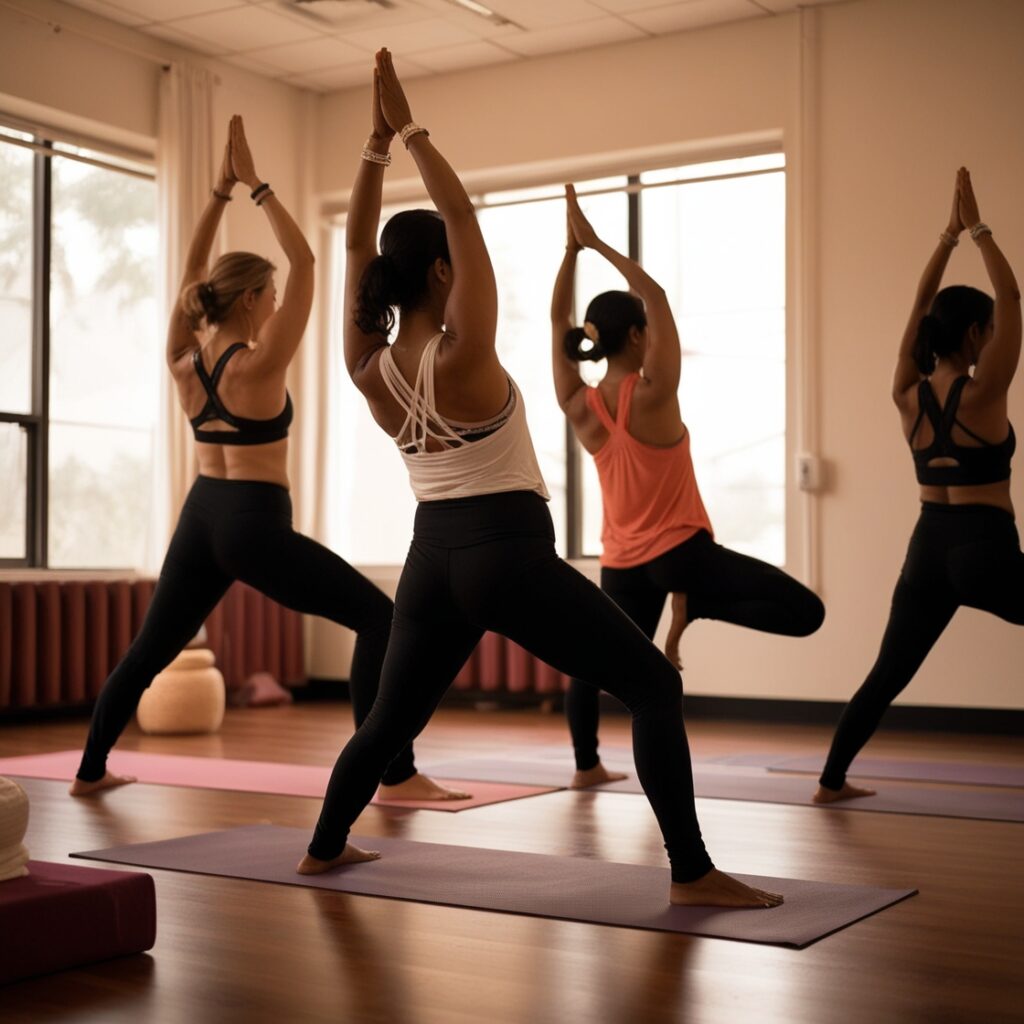The world is now gearing up for the FIFA World Cup 2026. But, behind the scenes, another powerful force has silently started shaping the future of FIFA matches, and that is Yoga. The world excitement is already in the air. Stadiums are under construction; nations are preparing their squads, and fans throughout the world are fueling up with the dreams of glory.
From the busy streets of Rio de Janeiro of Brazil, to the various training campuses of the USA, Mexico, and Canada, since these three countries are going to host this FIFA World Cup 2026. Every corner of Football lovers of the globe is buzzing with anticipation. The FIFA World Cup should not be seen just as a tournament, but it is the platform where billions of people unite with passion, pride, and pure adrenaline.
Once upon a time, the practice was seen for calm and stillness, but today Yoga has sneaked into these high-intensity elite sports training campuses for transforming the way the footballers train, recover, and compete.
Starting from world elite Superstars like Cristiano Ronaldo, Lionel Messi, and Kylian Mbappe, Ronaldinho Gaucho to other players are preparing themselves for the biggest stage of the FIFA World Cup 2026. Yoga is becoming a trusted ally to them, not for their flexibility but for focus, injury prevention, endurance, and mental performance. With the mounting pressure from the world football lovers, can ancient practice be the secret ingredient to a prestigious FIFA World Cup victory?
The science says “YES”, the road to FIFA World Cup-2026 may run right through the YOGA MAT.
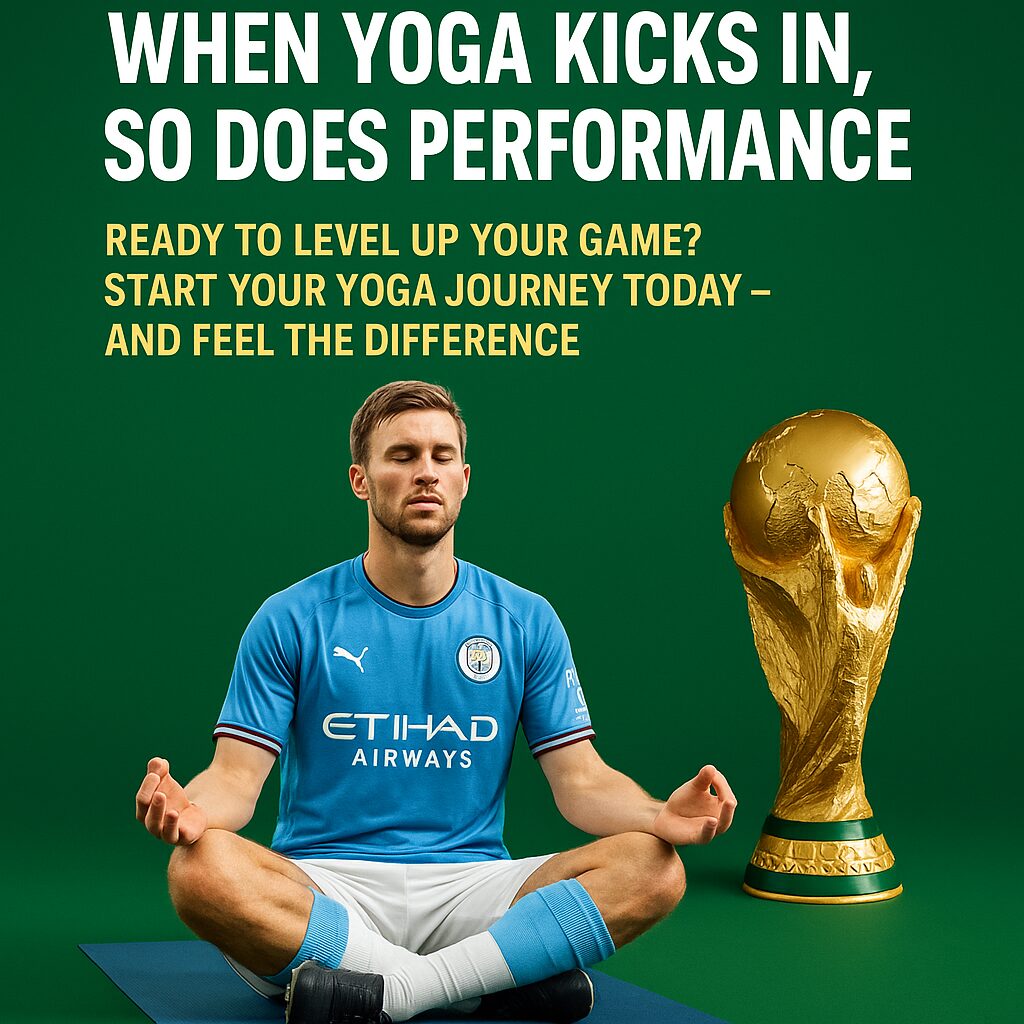
1. The Hidden Struggle behind the Win of the ensuing FIFA World Cup 2026:
Football fans throughout the world never see the hidden struggle faced by their Superstars. Every match played at the international level pushes the players to their physical and emotional limits. 90 minutes of sprinting, strong tackles, and quick decisions come at a cost of physical fatigue, stiff muscles, and even injuries.
Not only do the Superstars take the hit but also, but they also face the mental strain of competing on the high-voltage world stage – facing criticism, media pressure, and fear of losing the game, triggering burnout, anxiety, and loss of focus. Therefore, it demands resilience, quick recovery, and razor-sharp mental clarity. Here, YOGA emerges as a game-changing tool that is a powerful solution to football’s most pressing challenges for the FIFA World Cup 2026.
There are various examples of injuries; a few of the important examples are cited here:
Neymar Jr. missed the key Brazil FIFA World Cup matches during both 2014 and 2022 due to serious injury – a fractured vertebra and a sprained ankle. Harry Kane, who faced several hamstring injuries during Premier League matches, raised concerns about his fitness before international matches. Even the Superstar Lionel Messi, in spite of his brilliance, had faced dips in form during high-voltage matches led to fatigue and mental burden.
Another glaring example of a penalty shootout. The legends like Cristiano Ronaldo and Kylian Mbappe had missed the decisive shots under extreme mental pressure. These moments led them to extreme mental agony, not due to their brilliant techniques but for their mental composure, breath control, and the ability to keep themselves calm when the world spectators are watching the game.
In the high-voltage FIFA World Cup matches where margins are razor-thin, both the players and the coaches started realizing that peak performance is not just about speed and strength, but it is also about balance, recovery, and emotional regulation. Here’s how exactly YOGA can help them to excel.
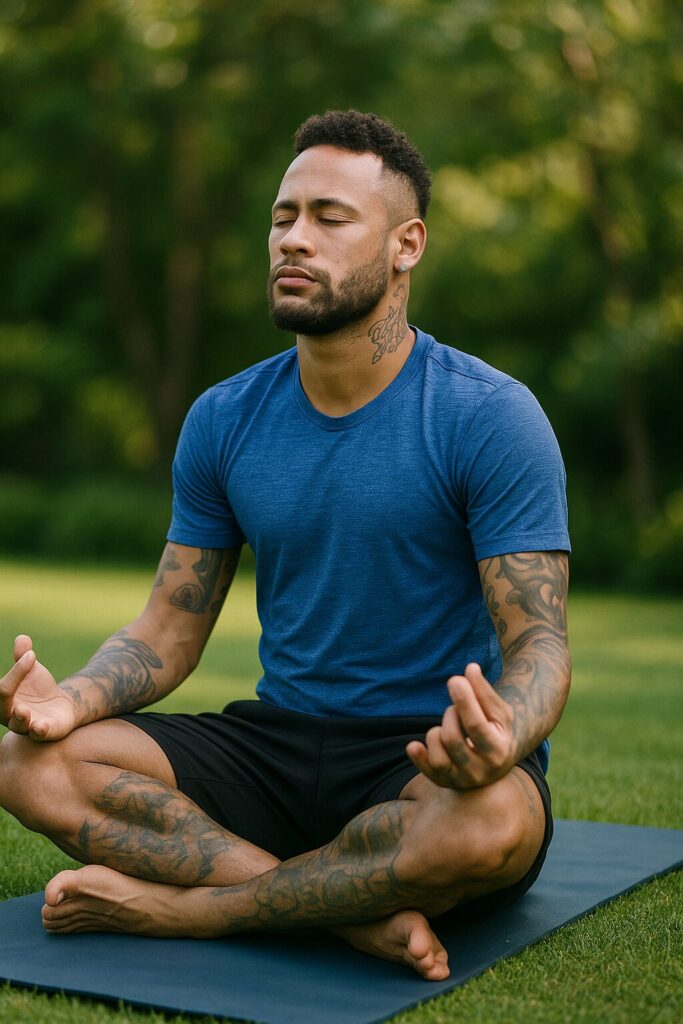
2. The Science behind Yoga and Athletic Excellence in the FIFA World Cup:
Science of Yoga and Neuromuscular Co-ordination:
Research conducted by the Department. Faculty of Sports Studies, Faculty of Medicine and Health Science, University Putra, Malaysia suggests that Neuromuscular training impacts an athlete’s physical fitness (balance, agility, speed, muscular power, and muscular endurance) in improving the performance of Motor Muscles, which speeds up the subcortical control system. According to the study, it suggests that Neuromuscular Training focuses on performing exercises, yoga postures that support brain training of the muscles and nerves to improve communication by coordinating the players’ body and subconscious mind.
A successful training should start at the beginning of the season and should continue for at least 12 weeks before starting the FIFA World Cup matches. The training components, as suggested by the studies, include balance, proprioception, plyometrics, strength training, and feedback after proper training. The effects of Neuromuscular training on other physical fitness include coordination, reaction times, flexibility, cardiovascular fitness, and body composition. Therefore, Neuromuscular Training is an essential part for improving the Athletes/Footballers’ performance in regard to muscular power, balance, by agility to change slower/faster direction more quickly, which are essential ingredients for the players in the FIFA World Cup matches.
A narrative review of the studies found that Yoga can enhance the learning rate, accuracy, and speed of motor tasks by improving attention and reducing stress, improving sensorimotor control and self-regulation.
Benefits for Elite Footballers: Neuromuscular Training enhances a Footballer’s performance by:
- Sharper foot placement and pivot control by enabling quicker direction change in the high-voltage FIFA World Cup matches
- Better body alignment in rough tackling, sprints, and aerial duels by reducing coordination errors.
- Faster reaction time in a high-voltage situation – opponents, rebounds, or counterattacks.
3. Why does it matter for the Football and the FIFA World Cup 2026?
Yoga’s systematic approach to balance, breathe, body awareness, and mindful movement strengthens the neuromuscular activities relating to:
- Enhanced Motor learning and precision
- Perfect coordination under pressure
- Better injury prevention through improved alignment
In a sport like Football, where milliseconds and millimeters matter, neuromuscular fitness achieved by Yoga can take a player from GOOD to WORLD CLASS in the FIFA World Cup 2026.
World-class players practicing yoga:
Cristiano Ronaldo: A well-renowned Portuguese Footballer, a recipient of five Ballon d’Or awards and four European Golden Shoes, and well-known for his physical prowess, technical skills, and unmatched dedication to the game. Beyond his athleticism and discipline, there is also a lesser-known aspect in his daily routine, and that is Meditation and Mindfulness. These practices helped him to achieve his peak. Rolando’s Yoga journey serves as a powerful example of how integrating Meditation, Mindfulness, and other related practices can enhance performance, reduce stress, and improve overall well-being.
Lionel Messi: Lionel Messi, who is also known as Leo Messi and Lionel Andres Messi, is a legendary soccer player from Argentina who helped his team win the FIFA World Cup 2022. He is widely regarded as one of the greatest players in the world. He set numerous individual records throughout his professional career.
However, his success did not come free. This Argentinian, “Little Magician,” has been practicing Yoga to stay fit, to maintain himself calm in high-voltage matches, and to try to stay away from physical strain such as shoulder pain, hamstrings, and other injuries. After heavy workouts throughout the day, this legendary Footballer ends his day with a Power Yoga routine that helps him to keep calm, rejuvenated, and strain-free. This Power Yoga with Meditation program was designed by Rodnee Yee, an American Professional Yoga Instructor.
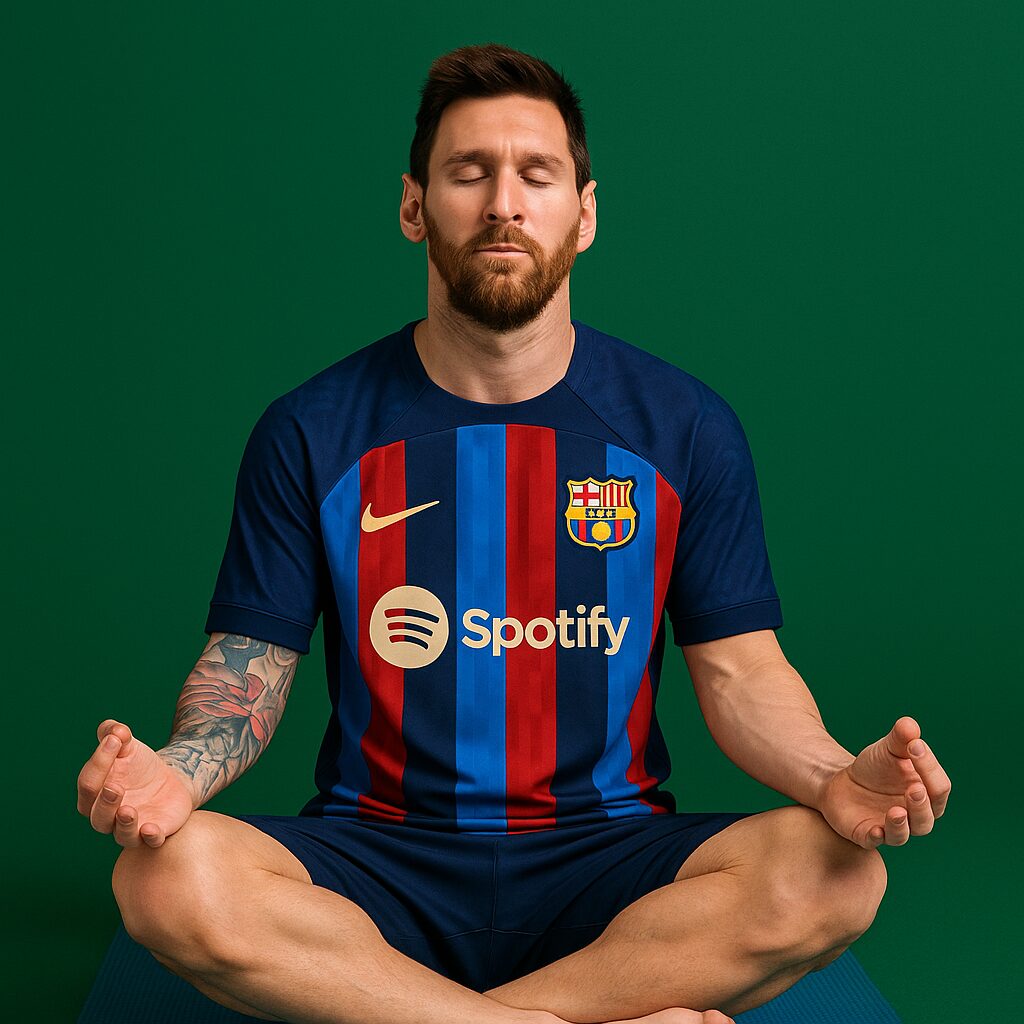
David Silva: David Josue Jimenez Silva, a left-footed midfielder, is a Spanish Footballer who plays for Manchester City. He is usually called “Merlin” because of his passing and retaining capabilities in the midfield. As a very successful player, he has won the FIFA World Cup in 2010 and the UEFA Euro Cup 2012.
Such a legendary Midfielder is also practicing Yoga and Meditation. Ryan Giggs introduced David Silva to this unique art, and up to a great extent, trained him “how to practice it”.
Once David Silva said, “I have taken up this unique art from Ryan Giggs. It has been another way of helping me stretch out after games. It has helped me to get back in shape and form”.
4. 7 Ways of Yoga Powers for FIFA World Cup Players:
| Benefits | Impact of Players |
| Flexibility | Reduces Hamstring, Groin, and Injuries |
| Mental Calmness | Sharpen decision-making under pressure |
| Breathe control | Boosts stamina in extra time |
| Core Stability | Improves dribbling, balance, and power |
| Faster Recovery | Less fatigue between back-to-back matches |
| Body Awareness | Enhances positioning and agility |
| Team cohesion | Builds unity through a group yoga session |
5. Which Teams are embracing Yoga for winning in the FIFA World Cup 2026?
So far and so long, we have some information on the above.
i. Team England: During the period Euro-2024, England invited Dr. Rebekah Jade Lawrence, an award-winning Yoga Teacher and Physician, to impart training to the England squad on Breathing exercises, Stretching, and Meditation for early recovery of injuries, sharpening the players’ quick decision-making, and boosting stamina in the FIFA World Cup 2026 matches.
She wrote on Instagram, “Wow, thank you, England Football team, for inviting me to teach YOGA as part of the recovery process”.
ii. France: Didier Deschamps has been appointed as the National Team Boss for the FIFA World Cup 2026. There has been no official announcement on appointing a Yoga Instructor for the players. But individual players like Kylian Mbappe are adopting recovery camps and meditation.
France has also adopted several yoga-based recovery protocols, particularly during their training period. Renowned players in the France squad like Antoine Griezmann and Paul Pogba continue their stretching routine, dynamic mobility flow, and guided breathing techniques for:
- Post-Match Muscle Tension
- Mental focus before high voltage matches
- Travel fatigue
As the Global competition intensifies, several countries are trying to set their standard by blending traditional Football drills with modern sports science and yoga-based recovery.
So far, this information has been collected.
iii. Germany: Germany is well known for its scientific and disciplined Soccer squad. Before winning the FIFA World Cup 2014, Germany very quietly introduced Yoga and Meditation practices into their training regimen. Players practiced a guided Yoga session for:
- Flexibility and strength
- Breathe control and nervous system regulation
- Injury prevention and quick recovery.
6. Yoga Training for Footballers (A Sample Plan) for FIFA World Cup 2026:
Warm-up routine:
Cat-Cow Pose: Another name for the Cat-Cow pose is Marjara Asana. It is often practiced at the beginning to warm up the spine. It is a gentle yoga pose that links breaths with movement. It is usually done on hands and knees as a part of warm-up or cool down.
How to perform:
Sit in Vajrasana. Raise the buttocks and stand on the knees. Lean forward and place your hands flat on the floor beneath your shoulders with the fingers facing forward. The hands should be in line with the knees, the arms and thighs should be perpendicular to the floor. The knees may be together or apart. This is the starting position. Inhale when you are raising your head and depressing the spine. Expand the abdomen fully and fill the lungs with the full amount of air. Hold your breath for some time and then exhale.
Benefits: This Cat-Cow pose improves the flexibility of the neck, shoulders, and spine. It relieves Lower Back tension, encourages better posture, boosts circulation and energy flow, and soothes stress and anxiety.

Sun Salutation (Surya Namaskar): This is a foundational sequence in yoga that combines breath and movement for a full-body workout. Surya Namaskar is a combination of 12 yoga poses that helps to improve flexibility, metabolism, and mental clarity.
How to Perform: Performing 12 poses are given below:
- Pranamasana (Prayer Pose): Stand tall with the feet together. Join the palms together in front of the chest. Inhale and exhale in equal numbers. The benefit is centering and grounding.
- Hasta Utthanasana (Raised Arm Pose): Stretch arms overhead and inhale. Gently arch the back for lifting the chest. This pose improves digestion, stretches the chest and abdomen.
- Utthanasana (Standing Forward Bend): Stand tall and inhale fully. Exhale and bend forward from the hips to keep the spine long. Try to touch the floor. This is beneficial for strengthening legs and stretching hamstrings.
- Ashwa Sanchalanasana (Equestrian Pose): Stand tall and Inhale fully. Step the right leg back, lower the knee, and try to look up. This pose helps to open the hips and strengthen the thighs.
- Dandasana( Plank Pose ): Exhale to blow out the air completely. Step the left leg back to form a straight plant. This helps to strengthen the arms.
- Ashtanga Namaskara (Salute with eight parts/points): Lower the knees, chest, and chin to the floor. Finally, only the toes, knees, chest, hands, and chin touch the floor. The knees, chest, and chin should touch the floor simultaneously. If it is not possible, then first lower the knees, then the chest, and finally the chin. The buttocks, hips, and abdomen should be raised. This provides the practitioners with strength in arms and increases body awareness.
- 7. Bhujangasana (Cobra Pose): Inhale fully. Now, lower the buttocks and hips to the floor. Strengthen the elbows, arch, and back, and push the chest forward into the cobra pose. Bend your head back and direct your look upward to the eyebrow center. Try to keep the thighs and hips on the floor and the arms supporting the trunk. Remain in the same position unless the spine becomes flexible, and the arms will remain slightly bent. This will help to open the chest and tone the spine.
- Adho Mukha Svanasana (Downward-facing Dog pose): Inhale fully and lift the hips into an inverted V-shape. Exhale and come to normal. This will help to energize the body, stretch the spine, and legs.
- Ashwa Sanchalanasana (Repeat Equestrian Pose): Inhale fully and step the right foot forward between the hands. Exhale and come to the normal position. Repeat this for 5/10 times. This will help to open the hips and strengthen the thighs.
- Uttanasana (Repeat forward Bend): Exhale fully and then bring the left leg forward and bend down. This will help to stretch the spine and legs.
- Hasta Uttanasana (Repeat raised arms pose): Raise hands up and gently back bend. Exhale to come back to normal. This will help to expand the lungs and release tension.
- Pranamasana (Repeat to Prayer Pose): Stand tall with the feet together. Join the palms together in front of the chest. Inhale and exhale in equal numbers. The benefit is centering and grounding. And also improves the nervous system.

Benefits of Suryanamaskar:
i.It enhances blood circulation
ii. Improves flexibility, balance, and coordination
iii. Builds core strength and lung capacity
iv. Reduces stress and sharpens focus.
All the above are enough and beneficial for all Athletes and especially the FOOTBALLERS for the ensuing FIFA World Cup 2026.
07. Conclusion: In this fast-paced world of elite football, where every step, every second counts, every movement matters, and every decision can change the result of the game where strength, speed, and strategy remain vital. Today, the edge lies in something deeper, where balance, recovery, focus, and mental clarity are required. That’s where YOGA comes in. And when it is performed in true spirit, the peak and desired performance can be achieved in high-voltage matches like the FIFA World Cup 2026.
Not only are elite athletes like Lionel Messi, Cristiano Ronaldo, and Erling Haaland working harder, but they are also training more intelligently. They are gaining greater control over their bodies, increased focus, and quicker recuperation by adopting yoga. With the support of science and practice, yoga is evolving from a side practice to a game-changing strategy for winning the FIFA World Cup 2026.
ARE YOU READY TO REACH YOUR PEAK PERFORMANCE? START YOUR YOGA JOURNEY TODAY AND REALISE THE DIFFERENCE WHEN PERFORMANCE MATTERS
FQA:
Question 1: Why are top Footballers like Messi practicing Meditation and Yoga?
Ans: Top Footballers like Lionel Messi usually practice yoga and meditation to improve focus, balance, recovery, and mental clarity. These techniques help him to manage high-voltage match-day stress, reduce injury risk, and sustain performance across the intense tournament schedule.
Question 2: Can Yoga really improve a Footballer’s performance?
Ans: Yes. Scientific studies indicate that Yoga enhances neuromuscular coordination and strengthens the core muscles. These are all crucial for Footballers during high-speed sprints, tough tackles, and ball control.
Question 3: Is Yoga being used by FIFA World Cup 2026 teams?
Ans: Yes. Teams like England, Germany, France, and Japan have introduced Yoga-based recovery, breath work, and mindfulness into their training camps, especially for the preparation of high-voltage international tournaments like the FIFA World Cup -2026.
Question 4: What type of Yoga is best for Football players?
Ans: Footballers get the most benefit from dynamic Yoga flows like Power Yoga and Vinyasa Yoga for gaining strength and stability. Poses like Surya Namaskar, Tree Pose, and Warrior-II pose are highly beneficial for the players.
Question 5: Is Yoga useful for injury prevention?
Ans: Definitely! Yoga enhances joint stability, muscle elasticity, and balance, which will help the players to prevent injuries like hamstring, ankle sprains, and groin pulls.
Question 6: Has Yoga really helped Messi during matches?
Ans: While Messi does not talk much about Yoga, his mindful playing style and calm demeanor under pressure. His iconic composure is consistent with the benefits achieved through Meditation and breath-focused practices.
Question 7: Can Yoga be a secret advantage in the FIFA World Cup -2026?
Ans: Yoga may be the secret advantage. As most of the teams adopt smarter recovery plans and mind-body training strategies, Yoga could become a key differentiator. This is not just for recovery but for a sharper mental edge, greater endurance, and fewer injuries.
Question 8: What is the Mascot of the FIFA World Cup 2026?
Ans: The official mascot for FIFA 2026 is “Fazzy”, a vibrant and energetic character created to engage fans of every generation. Drawing inspiration from the passion of football and the cultural diversity of North America, Fazzy embodies inclusivity, joy, and the universal love for the game.
First revealed through a lively animated launch video, Fazzy proudly wears a jersey featuring the tournament’s logo and colors. Fans can expect to see this cheerful mascot come to life on official merchandise, inside stadiums, and at fan festivals throughout the FIFA World Cup 2026 experience.

9. Is Lionel Messi retiring from football?
Ans: It is learned that “Messi hinted his retirement from the National Team after the ensuing FIFA World Cup 2026, where Argentina is going to defend the title they won in the last FIFA World Cup.




